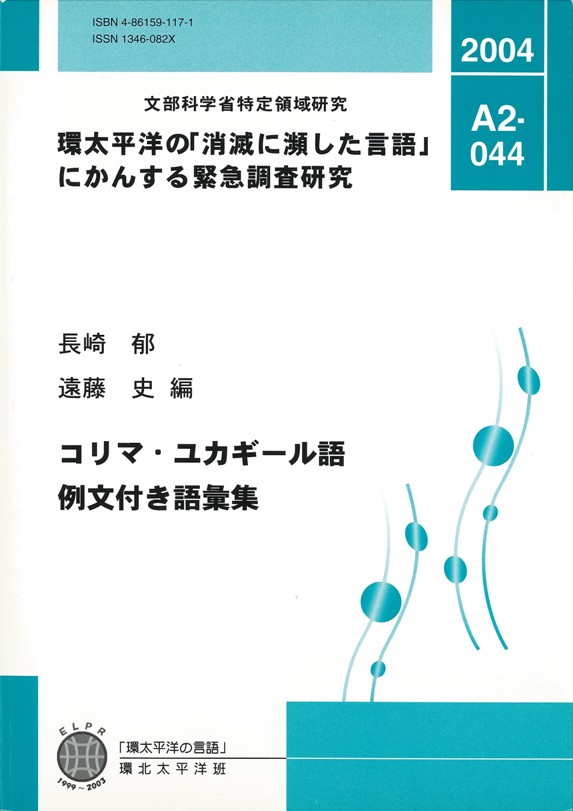A2班刊行物
宮岡 伯人・遠藤 史 編 『環北太平洋の言語 第6号』(A2-001)
Osahito MIYAOKA and Fubito ENDO eds.
"Languages of the North Pacific Rim Volume 6"
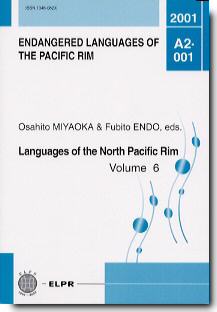
CONTENTS
| Preliminary Remarks on an Udehe Autobiographical Text: with a Sample of Shamanistic Episodes | Toshiro TSUMAGARI | 1 |
| Additional Basic Vocabulary of Kolyma Yukaghir | Fubito ENDO | 9 |
| Noun Incorporation in Koryak | Megumi KUREBITO | 29 |
| The Basic Principles of the Koryak Writing | Alevtina N. ZHUKOVA | 59 |
| On Lexical Affixes in Chukchi | Tokusu KUREBITO | 65 |
| Preliminaries to a Grammar of Central Alaskan Yupik | Osahito MIYAOKA | 85 |
| Classifiers in Skidegate Haida | Hirofumi HORI | 141 |
| Lexical Suffixes and Two Intransitive Suffixes in Sliammon Salish | Honoré WATANABE | 157 |
津曲 敏郎 編 『環北太平洋の言語 第7号』(A2-002)
Toshiro TSUMAGARI,ed. "Languages of the North Pacific Rim Volume 7"

目次
CONTENTS
CONTENTS
|
「北方諸言語」研究活動の記録 Preface |
津曲 敏郎 Toshiro TSUMAGARI |
1 |
|
スライアモン・セイリッシュ語の語彙的接尾辞と
ふたつの自動詞接尾辞について Lexical Suffixes and Two Intransitive Suffixes in Sliammon Salish |
渡辺 己 Honoré WATANABE |
11 |
|
海岸ツィムシアン語のアスペクト重複について On the Aspectual Reduplication in Coast Tsimshian |
笹間 史子 Fumiko SASAMA |
23 |
|
ハイダ語の類別接頭辞について Classifiers in Skidegate Haida |
堀 博文 Hirofumi HORI |
35 |
|
シベリア・ユピック語の名詞項修飾タイプ指小・指大辞について On Argument-Modifying Diminutives and Augmentatives in Central Siberian Yupik |
永井 佳代 Kayo NAGAI |
51 |
|
アリュート語テキスト分析試案 A Preliminary Report on Aleut Text Analysis |
大島 稔 Minoru OSHIMA |
71 |
|
チュクチ語の否定表現について On the Negation in Chukchi |
呉人 徳司 Tokusu KUREBITO |
87 |
|
コリャーク語の出名動詞と名詞抱合 Denominative Verbs and Noun Incorporation in Koryak |
呉人 恵 Megumi KUREBITO |
101 |
|
コリマ・ユカギール語における指示転換的現象について On Switch-Reference Phenomena in Kolyma Yukaghir |
遠藤 史 Fubito ENDO |
125 |
|
ツングース諸語における譲渡可能を示す接辞について On the suffix of alienability in Tungus languages |
風間 伸次郎 Shinjiro KAZAMA |
141 |
|
ウイルタ語動詞活用大要 A Concise Outline of the Verb Inflection of Uilta |
池上 二良 Jiro IKEGAMI |
157 |
|
1人称複数代名詞の除外/包括性について:満洲語文語の用例をもとに The First Person Exclusive/Inclusive Plural: with Reference to Manchu and Neighboring Languages |
津曲 敏郎 Toshiro TSUMAGARI |
167 |
|
シベ語の複数接尾辞 −s について The Plural Suffix -s in Sibe |
木村 滋雄 Shigeo KIMURA |
177 |
|
モンゴル語の名詞−動詞型複合動詞 [Noun-Verb] Compound Verbs in Modern Mongolian |
山越 康裕 Yasuhiro YAMAKOSHI |
193 |
|
再びアイヌ語の有音休止について The Pausal Repetition in Ainu Revisited |
佐藤 知己 Tomomi SATO |
209 |
|
日本語における語彙的な意味の単位をめぐって On the Lexical Units of Referential Meaning in Japanese |
早津恵美子 Emiko HAYATSU |
219 |
Lucille J. Watahomigie, Jorigine Bender,
Philbert Watahomigie, Sr. and Akira Y. Yamamoto [山本 昭]
with Elnor Mapatis, Malinda Powskey and Josie Steele
『ワラパイの言葉:文法と用法』(A2-003)
"Hualapai Reference Grammar (Revised and Expanded Edition)"
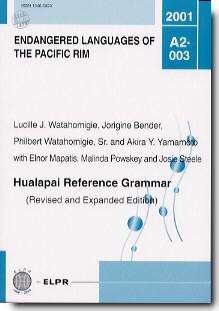
CONTENTS
| Preface and Acknowledgement | |
| Abbreviations | |
|
Part I Introduction |
1 |
|
Part II Constructing A Sentence |
35 |
|
Part III Elements of the Sentences: Noun Phrases |
141 |
|
Part IV Elements of the Sentences: Verb Phrases |
225 |
|
Part V Mood, Different Ways of Expressing the Speaker's Attitudes |
381 |
|
Part VI Expanding Sentences |
412 |
|
Part VII Beyond Sentences: Useful Expressions and Examples of Connected Texts |
443 |
| Index | 501 |
| Appendices: Vocabulary In This Book | 516 |
呉人 恵 編『コリャーク語民話テキスト カワヒメマスとカレイ』
(A2-004)
Megumi KUREBITO ed. "KORYAK FOLKTALE: THE GRAYLING AND THE FLATFISH"


風間 伸次郎 採録・訳注
『ナーナイの民話と伝説 6(ツングース言語文化論集15)』(CD8枚付き)(A2-005)
Shinjiro KAZAMA ed. "Nanay Folk Tales and Legends 6 (Publications on Tungus
Languages and Cultures 15)" (with 8 CDs)
目次
CONTENTS
CONTENTS
|
まえがき 接辞一覧表 Preface |
1 |
|
あらすじ (和文・英文) Summary of the stories |
7 |
|
テキスト本文 (ラテン文字に基づく音韻表記とその日本語訳) Texts in Roman transcription with Japanese translation |
|
|
1. 犬怪人 The dog monster. |
27 |
|
2. 毛皮外套の切れ端 The scrap of fur mantle. |
63 |
|
3. 姉と妹が暮らしていた There lived two sisters. |
101 |
|
4. 二人のムルグンが暮らしていた There lived two brothers. |
130 |
|
5. 二人の少年が暮らしていた There lived two boys. |
157 |
|
6. あるプジンが住んでいた There lived a Pujin. |
178 |
|
7. 一人のムルグンが一人きりで暮らしていた There lived a Mergen alone. |
205 |
|
8. 人形で遊ぶ娘 The daughter who plays with the dolls. |
234 |
|
9. 一匹のカエルと一人のプジンが暮らしていた There lived a Pujin and a frog in a house. |
266 |
|
10. ユルギームルグン Yurgi Mergen |
274 |
|
11. 一人のムルグンが暮らしていた There lived a Mergen. |
309 |
|
12. 一人のプジンと女奴隷とが暮らしていた There lived a Pujin with her female slave. |
335 |
|
テキスト本文(キリル文字に基づく音韻表記) Texts in Cyrillic transcription |
357 |
D.ワーガイー・永井 佳代 著
『セント・ローレンス島ユピック・エスキモー語 テキストおよび文法分析』(A2-006)
Della Waghiyi and Kayo NAGAI
"Mrs. Della Waghiyi's St. Lawrence Island Yupik Texts
with Grammatical Analysis"
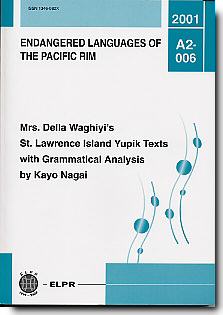
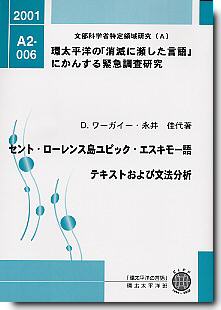
CONTENTS
| INTRODUCTION | 1 |
| PART I | |
| I. KIIGMI SIVUNGAMI | 6 |
| II. NEQEPIK | 16 |
| III. NEQEKRANGLLAQ | 18 |
| IV. MANGTEGHAPIK | 22 |
| V. TEMKAAK | 24 |
| VI. ILEPGHAAGHET | 26 |
| VII. KAMEK | 28 |
| VIII. SANAGHTA | 32 |
| IX. UYGAAQ | 34 |
| X. IMLAANGIIGHHAAT | 38 |
| XI. UGTINGHAQ | 40 |
| XII. SUKILPAQ | 44 |
| XIII. IGHNEGHLLUK | 48 |
| XIV. SIIGNAQ | 52 |
| PART II | |
| I. KIIG-MI SIVUNGA-MI | 57 |
| II. NEQE-PIK | 97 |
| III. NEQE-KRA-NGLLAQ | 101 |
| IV. MANGTEGHA-PIK | 109 |
| V. TEMKA-A-K | 115 |
| VI. ILEPGHAAGH-E-T | 123 |
| VII. KAMEK | 131 |
| VIII. SANAGHTA | 147 |
| IX. UYGAAQ | 153 |
| X. IMLAANGIIGHHAAT | 167 |
| XI. UGTINGHAQ | 173 |
| XII. SUKILPAQ | 183 |
| XIII. IGHNEGHLLUK | 191 |
| XIV. SIIGNAQ | 205 |
| ABBREVIATIONS AND SYMBOLS | 213 |
| REFERENCES | 215 |
村崎 恭子 編訳, 峰岸 真琴 CD-ROM編集
『CD−ROM版 浅井タケ昔話全集』(CD2枚付き)(A2-007)
Kyoko MURASAKI & Makoto MINEGISHI eds.
"CD-ROM Tuytan Collection by ASAI Take
— Complete Text and Sound of 54 Fairy Tales Narrated
by the Last Speaker of Sakhalin Ainu —"(with 2 CDs) (in Japanese)
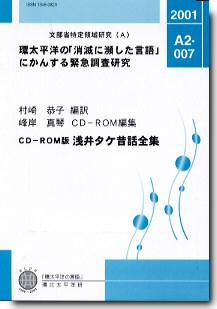
田村 すず子 編『アイヌ語沙流方言の音声資料1 —
近藤鏡二郎の録音テープに遺されたワテケさんの神謡』(CD1枚付き)(A2-008)
Suzuko TAMURA ed. "Ainu Language: Audio Recordings
of the Saru Dialect 1 — Mythical Chants Recited
by Wateke Preserved on Tape Recorded by Kyojiro KONDO" (with 1 CD)
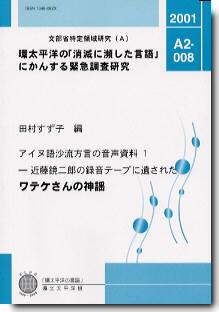
目次
CONTENTS
CONTENTS
|
はしがき Preface |
|
|
研究経過 Record of Research Progress |
1 |
|
語り手紹介 Speaker Introduction |
7 |
|
録音者紹介 Recorder Introduction |
9 |
|
凡例 Transcription, Abbreviations, etc. |
10 |
|
話者の方言所在地 Speaker Informant's Dialect Site Map |
20 |
|
ワテケさんの神謡 Mythical Chants Recited by Wateke |
21 |
|
1. アマメチカッポ ... 雀 Amamecikappo ... The Sparrow |
23 |
|
補説 Supplement |
46 |
|
2. ウパㇱチロンヌㇷ゚ ... オコジョ Upascironnup ... The Ermine |
57 |
|
補説 Supplement |
82 |
|
3. サロルンチカッポ ... ヨシキリ Saroruncikappo ... The Reed Warbler |
87 |
|
補説 Supplement |
106 |
|
4. ヘペㇾ ... 小熊 Heper ... The Young Bear |
111 |
|
補説 Supplement |
134 |
|
5. ウイマㇺレプンカ ... 交易航海 Uymamrepunka ... The Bartering Trade Voyage |
139 |
|
補説 Supplement |
208 |
|
索引 Indexes |
215 |
|
行索引 Line Index |
217 |
|
単語索引 Word Index |
225 |
村崎 恭子 編『少数民族言語資料の記録と保存 ―樺太アイヌ語とニヴフ語―』
(A2-009)
Kyoko MURASAKI ed. "Recording and Restoration of Materials
of Minority Languages — Sakhalin Ainu and Nivkh Languages —"
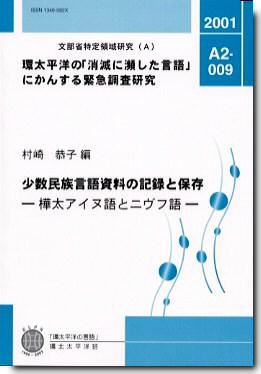
目次
CONTENTS
CONTENTS
|
はじめに Preface |
村崎 恭子 Kyoko Murasaki |
|
|
ペテルブルグ資料調査2000について Schedule of Study Visit to St. Petersburg 2-10 October 2000 |
T. ヴィヘルケヴィチ Tomasz Wicherkiewicz |
1 |
|
プーシキン古資料館のロウ管研究室を訪れて Report of the Visit to Wax Cylinder Laboratory at Pushkin Dom |
中村 隆 Takashi Nakamura |
5 |
|
ロシアにおける歴史的言語資料、音声資料館調査研究報告 Data on the Languages of Russia from Historical Documents, Sound Archives and Fieldwork Expeditions |
T. デ・グラーフ Tjeerd de Graaf |
13 |
|
音声資料からの雑音除去 Noise Reduction from Sound Date |
中村 隆 Takashi Nakamura |
39 |
|
B. ピウスツキ収録のニブフ語民俗資料について — ペテルブルグ資料 — B. Pilsudski's Collection of Nivkh Folklore Texts in St. Petersburg |
E. グルジェバ E. Gruzdeva |
47 |
|
サハリンアイヌ散文説話の一ジャンルtuytahについて
—「挿入歌」からみた文字資料 — On the Form of Sakhalin Ainu Folktale "Tuytah" Inserted Songs in Written Texts of Tuytah |
丹菊 逸治 Itsuji Tangiku |
69 |
|
B. ピウスツキ収録の昔話11編と民話1編
— 再転写によるアイヌ語テキストと日本語訳 — Sakhalin Ainu Texts of 11 Fairly Tales and a Tale of Tradition Collected by Bronislaw Pilsudski — Reliterated Version |
村崎 恭子 Kyoko Murasaki |
91 |
村崎 恭子 編訳『改訂 浅井タケ昔話全集』(A2-010)
Kyoko MURASAKI ed. "Tuytan Collection by ASAI Take revised edition
— Complete Text of 54 Fairy Tales Narrated by the Last Speaker
of Sakhalin Ainu —" (in Japanese)
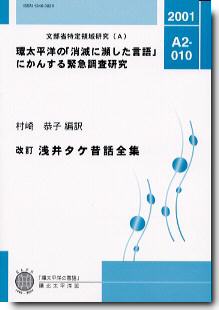
目次
CONTENTS
CONTENTS
| はじめに | |
| 凡例 | |
| 樺太アイヌの昔話TUYTAHについて | |
| 樺太アイヌ語の行方 | |
| 樺太アイヌ語発音のあらまし | |
| 収録昔話一覧 | 1 |
| 昔話テキスト | 2 |
| Preface | 578 |
呉人 恵 編,呉人 徳司,呉人 恵,永山 ゆかり,小野 智香子,谷津 光宏
『チュクチ・カムチャッカ語族 比較基礎語彙集:1』(A2-011)
Megumi KUREBITO ed. Tokusu KUREBITO, Megumi KUREBITO, Yukari NAGAYAMA,
Chikako ONO, and Mitsuhiro YAZU
"Comparative Basic Vocabulary of the Chukchee-Kamchatkan Language Family: 1"
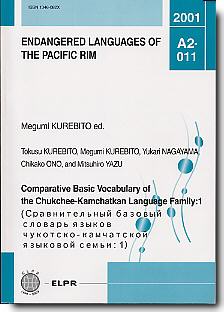
CONTENTS
| EDITOR'S WORDS | |
| Introduction | 1 |
| The Present Work | 2 |
| Tables of Phonemes of the Chukchee-Kamchatkan Language Family | 4 |
| ОТ РЕДАКТОРА | |
| Введение | 8 |
| О настоящем изданин | 9 |
| Таблицы Фонем языков чукотско-камчатской языковой сеиьи | 12 |
|
A TABLE OF CORRESPONDENCE BETWEEN THE LATIN TRANSCRIPTION
AND THE CYRILLIC TRANSCRIPTION (ТАБЛИЩА СООТВЕТСТВИЙ МЕЖДУ ЛАТИНСКОЙ ТРАНСКРИПЦИЕЙ И КИРИЛЛИЦЕЙ) |
15 |
| REFERENCES | 16 |
| COMPARATIVE BASIC VOCABULARY OF THE CHUKCHEE-KAMCHATKAN LANGUAGE FAMILY IN THE LATIN TRANSCRIPTION | 17 |
| COMPARATIVE BASIC VOCABULARY OF THE CHUKCHEE-KAMCHATKAN LANGUAGE FAMILY IN THE CYRILLIC TRANSCRIPTION | 119 |
| INDEX | 221 |
津曲 敏郎 編『環北太平洋の言語 第8号』(A2-012)
Toshiro TSUMAGARI ed. "Languages of the North Pacific Rim Volume 8"
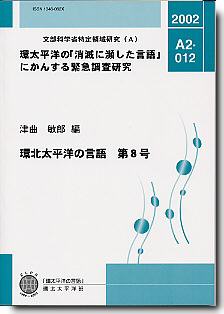
目次
CONTENTS
CONTENTS
|
海岸ツィムシアン語における名詞と動詞の区別について On the Noun-Verb Distinction in Coast Tsimshian |
笹間 史子 Fumiko SASAMA |
1 |
|
アリュートル語の関係形容詞と所有形容詞 Relative and Possessive Adjectives in Alutor |
永山ゆかり Yukari NAGAYAMA |
11 |
|
ツングース諸語における「使役」を示す形式について On the "Causative" Forms in Tungus Languages |
風間伸次郎 Shinjiro KAZAMA |
37 |
|
シベ語のピッチアクセントについて On the Pitch-Accent of Sibe |
木村 滋雄 Shigeo KIMURA |
51 |
|
ニヴフ語の魚名と漁労語彙(1) Nivkh Fish Names (1) |
丹菊 逸治 Itsuji TANGIKU |
61 |
|
アイヌ語沙流方言の民話:上田トシのウエペケレ Folktales of the Saru Dialect of Ainu: Ueda Toshi's Uepeker |
白石 英才 Hidetoshi SHIRAISHI |
71 |
|
シネヘン・ブリヤート語テキスト Texts of Shinekhen Buriyat |
山越 康裕 Yasuhiro YAMAKOSHI |
95 |
|
言語の危機と21世紀言語学の課題 Language Endangerment and the 21st Century Linguistics |
津曲 敏郎 Toshiro TSUMAGARI |
131 |
池上 二良 採録・訳注『増訂 ウイルタ口頭文芸原文集(ツングース言語文化論集16)』
(CD1枚付き)(A2-013)
Jirô IKEGAMI tr. and annot. "UILTA ORAL LITERATURE
A Collection of Texts Revised and Enlarged Edition
(Publications on Tungus Languages and Cultures 16)" (with 1 CD)
目次
CONTENTS
CONTENTS
|
序 Foreword |
i |
|
第1部 (28篇) Part 1 (28 texts) |
1 |
|
第2部 (16篇) Part 2 (16 texts) |
107 |
|
第3部 (英文 4篇) Part 3 (in English 4 texts) |
139 |
佐藤 知己 編『アイヌ語諸方言調査報告(1)』(A2-014)
Tomomi SATO ed. "Preliminary Reports on Ainu Dialects (1)"
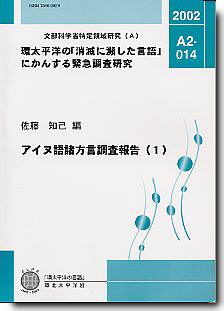
目次
CONTENTS
CONTENTS
|
調査および調査結果の概要 Introduction |
佐藤知己 Tomomi SATO |
1 |
| "Hekaci"(The Story of a Boy) By Oda Ito | Bugaeva Anna | 8 |
|
上田トシ氏のアイヌ語資料について Notes on the Materials of Toshi Ueda |
佐藤知己 Tomomi SATO |
39 |
| 上田トシ氏のアイヌ語資料(平成12年5月26日) | 佐藤知己 | 45 |
| 上田トシ氏のアイヌ語資料(平成12年5月26日)索引 | 佐藤知己 | 79 |
| 上田トシ氏のアイヌ語資料(平成13年12月28日) | 佐藤知己 | 100 |
| 上田トシ氏のアイヌ語資料(平成13年12月28日)索引 | 佐藤知己 | 111 |
|
日高東部方言、道東方言のアイヌ語資料について Notes on the Data of the East Hidaka and East Hokkaido Dialects of Ainu |
高橋靖以 Yasushige TAKAHASHI |
117 |
| 浦川リウ氏のアイヌ語資料 | 高橋靖以 | 122 |
| 浦川リウ氏のアイヌ語資料索引 | 高橋靖以 | 135 |
| 細川一人氏のアイヌ語資料 | 高橋靖以 | 144 |
| 細川一人氏のアイヌ語資料索引 | 高橋靖以 | 148 |
| 増野光教氏のアイヌ語資料 | 高橋靖以 | 150 |
| 増野光教氏のアイヌ語資料索引 | 高橋靖以 | 167 |
| 根元与三郎氏のアイヌ語資料 | 高橋靖以 | 177 |
| 根元与三郎氏のアイヌ語資料索引 | 高橋靖以 | 182 |
| 小鳥サワ氏のアイヌ語資料 | 高橋靖以 | 183 |
| 小鳥サワ氏のアイヌ語資料索引 | 高橋靖以 | 200 |
白石 英才、ガリーナ・ローク 編(序文 中川 裕)
『ニヴフ語音声資料1 — V. アキリャーク=イヴァノーヴァの民話
— 』(CD1枚付き)(A2-015)
Hidetoshi SHIRAISHI & Galina D. LOK eds.
with Preface by Hiroshi NAKAGAWA
"Sound Materials of the Nivkh Language 1
— Folktales Recited by V.F.Akilijak - Ivanova — "
(with 1 CD) (in Russian)

田村 すず子編『アイヌ語沙流方言の音声資料2 —
近藤鏡二郎の録音テープに遺されたワテケさんの神謡Ⅱ』(CD1枚付き)(A2-016)
Suzuko TAMURA ed. "Ainu Language: Audio Recordings of the Saru Dialect
2 — Mythical Chants Recited by Wateke Preserved
on Tape Recorded by Kyojiro Kondo Ⅱ" (with 1 CD)
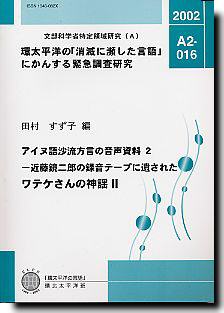
目次
CONTENTS
CONTENTS
|
はしがき Preface |
|
|
研究経過 Record of Research Progress |
1 |
|
語り手紹介 Speaker Introduction |
13 |
|
録音者紹介 Recorder Introduction |
19 |
|
凡例 Introductory Remarks and Legend |
21 |
|
話者の方言所在地 Speaker Consultants' Dialect Site |
50 |
|
ワテケさんの神謡 Mythical Chants Recited by Wateke |
51 |
|
6. カムイチカㇷ゚ ... シマフクロウ Kamuycikap ... The Fish Owl |
53 |
|
補説 Supplement |
102 |
|
7. シㇼカㇷ゚ ... ツノザメ Sirkap ... The Tusk Shark |
113 |
|
補説 Supplement |
152 |
|
索引 Indexes |
163 |
|
行索引 Line Index |
165 |
|
単語索引 Word Index |
171 |
|
神謡1〜5の旋律・抑揚譜 Melody and Intonation Diagrams for Mythical Chants 1 through 5 |
179 |
マリア・ニコラエーヴナ・プフタ 著 G.D.ローク、金子 亨 編
『ロシア語−ニヴフ語会話帳 及び ニヴフ語−ロシア語分類語彙集』(A2-017)
M.N.Puxta Galina D.LOK & Tohru KANEKO eds.
"Nivkh-Russian Conversation and Daily-Life Thesaurus"


目次
CONTENTS
CONTENTS
| I. 子供(1−1.5歳)のためのロシア語・ニヴフ語会話帳 | 1 |
| II. 事項別ニブフ語<アムール方言>会話手帖 | 7 |
| 1. お客さん | 7 |
| 2. 家族、親戚 | 10 |
| 3. 住む | 17 |
| 4. 学校 | 21 |
| 5. 船 | 23 |
| 6. 漁労 | 24 |
| 7. 猟 | 27 |
| 8. 菜園 | 29 |
| 9. 家を建てる | 30 |
| 10. 店 | 32 |
| 11. 輸送 | 34 |
| 12. 名人 | 36 |
| 13. 願い事 | 38 |
| 14. 健康 | 40 |
| 15. スポーツ | 42 |
| 16. 音楽 | 44 |
| 17. イチゴ狩り | 46 |
| III. ニブフ語・ロシア語・日本語分類語彙帳 | 50 |
| 1.ニヴフ料理 | 50 |
| 2. 食器類 | 58 |
| 3. 着物 | 61 |
| 4. 装飾の類 | 66 |
| 5. 身体 | 68 |
| 6. 生地 | 72 |
| 7. 民族呼称 | 74 |
| 8. 地名 | 75 |
| 9. 家畜 | 77 |
| 10. 虫・ヘビの類 | 80 |
| 11. 木 | 82 |
| 12. 鳥 | 84 |
| 13. 野生生物 | 86 |
| 14. 魚 | 88 |
| 15. 自然現象 | 90 |
| 16. 方位 | 97 |
| 17. 時間 | 101 |
| 18. 数 | 104 |
| 19. 海洋生物 | 108 |
呉人 恵、タチヤーナ・ユーリエヴナ・エルモリンスカヤ 編
『コリャーク民話「ワタリガラス」』(A2-018)
Megumi KUREBITO & Tat'yana Yur'yevna YERMOLINSKAYA eds.
"KORYAK FOLKTALE: THE RAVEN"
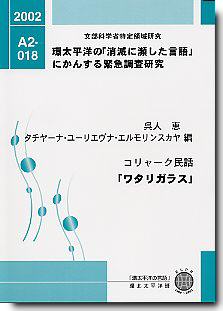
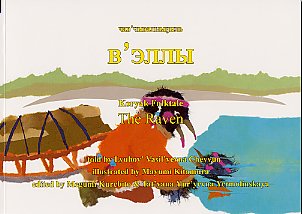
アレクサンドル・カンチュガ 著, 津曲 敏郎 編訳
『ウデヘ語自伝テキスト(ツングース言語文化論集17)』(CD1枚付き)(A2-019)
Aleksandr KANCHUGA edited with a Japanese Translation by Toshiro TSUMAGARI
"An Udehe Autobiographical Text with a Russian Translation (Publications on Tungus Languages and Culture 17)" (with 1 CD)
目次
CONTENTS
CONTENTS
| はじめに | i |
| Introduction | v |
|
ウデヘ語原文テキスト(日本語逐語訳付き) I〜XXXI Udehe text with Japanese translation |
1 |
|
ロシア語テキスト I〜XXXI Russian text |
251 |
風間 伸次郎 採録・訳注『ナーナイの民話と伝説7(ツングース言語文化論集18)』(CD2枚付き)(A2-020)
Shinjiro KAZAMA ed. "Nanay Folk Tales and Legends 7
(Publications on Tungus Languages and Cultures 18)" (with 2 CDs)
目次
CONTENTS
CONTENTS
| まえがき | 1 |
| 接辞一覧表 | 3 |
| あらすじ(和文) | 5 |
| あらすじ(英文)(Summary) | 9 |
| あらすじ(露文)(Содергание) | 15 |
| テキスト本文(ラテン文字に基づく音韻表記とその日本語訳) | |
| 1. 40頭の馬 (dəxi morin) | 21 |
| 2. 雌犬 (wəčəən) | 46 |
| 3. 姉と妹が暮らしていた (əika nəu balǰixani) | 55 |
| 4. 一人のおばあさんが娘と二人で暮らしていた (əm mamaačaan piktəmuliə balǰixani) | 72 |
| 5. 一人のプジンが一人きりで暮らしていた (əm puǰin əmučkəә̃n balǰixani) | 87 |
| 6. ピカチ (pikači) | 114 |
| テキスト本文(キリル文字に基づく音韻表記) | 132 |
風間 伸次郎 採録・訳注『ネギダール語 テキストと文法概説(ツングース言語文化論集19)』(CD1枚付き)(A2-021)
Shinjiro KAZAMA ed. "Negidal Texts and Grammar
(Publications on Tungus Languages and Cultures 19)" (with 1 CD)
目次
CONTENTS
CONTENTS
| まえがき | 1 |
| 資料編 | |
| あらすじ(和文) | 5 |
| あらすじ(英文)(Summary) | 8 |
| あらすじ(露文)(Содергание) | 11 |
|
テキスト本文(ラテン文字に基づく音韻表記とその日本語訳) Texts in Roman transcription with Japanese translation |
|
|
1. モモンガ (omkɪkkan) The flying squirrel |
15 |
|
2. ウムスニ (əməsəni) Emeseni |
23 |
|
3. 最初に天が生まれた (ələxəs bʊɣa baldɪča) In the beginning heaven was born |
30 |
|
4. ある人が暮らしていた (ɵmɵn bəjə baldɪča) A certain person lived |
37 |
|
5. ネギダール語による三番目の姉妹のエンマについての話 (razgovor pro tret'ju sestru emmu po negidal'skij) A talk about Emma |
44 |
|
テキスト本文(キリル文字に基づく音韻表記) Texts in Cyrillic transcription |
62 |
| ネギダール語基本文例 | 80 |
| 分析編 | |
| ネギダール語の音韻 | 98 |
| ネギダール語 接尾辞一覧表 | 100 |
| ネギダール語 文法概説 | 104 |
風間 伸次郎 採録・訳注『ウルチャ 口承文芸原文集2(ツングース言語文化論集20)』(CD2枚付き)(A2-022)
Shinjiro KAZAMA ed. "Ulcha Oral Literature 2 A Collection of Texts
(Publications on Tungus Languages and Cultures 20)" (with 2 CDs)
目次
CONTENTS
CONTENTS
| まえがき | 1 |
| あらすじ(和文) | 4 |
| あらすじ(英文)(Summary) | 8 |
| あらすじ(露文)(Содергание) | 12 |
|
テキスト本文(ラテン文字に基づく音韻表記とその日本語訳) Texts in Roman transcription with Japanese translation |
|
|
1. 棺桶 (xəul) The coffin |
17 |
|
2. 二人の女が暮らしていた (ǰuə əəktə baldaxati) Two women lived together |
1 |
|
3. 一人のおじいさんと一人のおばあさんが暮らしていた (ʊm mapa ʊm mama baldaxati) An old man lived with an old woman |
1 |
|
4. 伝説 (təəluŋgu) A legend |
1 |
|
テキスト本文(キリル文字に基づく音韻表記) Texts in Cyrillic transcription |
96 |
エルシー・メーサ、マリー・ミード、宮岡 伯人
『ユピック(エスキモー)語文法概観』(A2-023)
Elsie Mather, Marie Meade, Osahito MIYAOKA
"Survey of Yup'ik Grammar Revised"
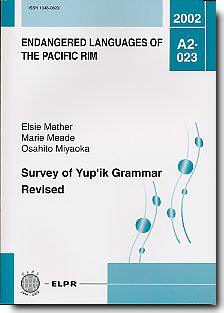
CONTENTS
| PREFACE | 1 |
| PART ONE | |
| INTRODUCTION | |
| I. CONSTITUTION OF A LANGUAGE | 7 |
| II. YUP'IK AS A POLYSYNTHETIC LANGUAGE | 12 |
| III. YUP'IK AS A SUFFIXING LANGUAGE | 15 |
| IV. YUP'IK AS AN AGGLUTINATIVE LANGUAGE | 17 |
| V. YUP'IK WITH RELATIVELY FREE WORD ORDER | 20 |
| WORDS | |
| VI. WORD CLASSES | 23 |
| VII. DERIVATION | 32 |
| VIII. PARTICLES | 38 |
| IX. ACCENT WHICH UNIFIES A WORD | 44 |
| PART TWO | |
| NOMINALS | |
| X. NUNBER | 55 |
| XI. CASE | 58 |
| XII. PERSON (POSSESSOR) | 69 |
| XIII. VARIOUS NOMINALS | 71 |
| XIV. NOMINAL PHRASES | 81 |
| VERBS | |
| XV. PERSON (SUBJECT AND OBJECT) | 86 |
| XVI. MOOD | 89 |
| XVII. VARIOUS VERBS | 100 |
| SENTENCES | |
| XVIII. CORES OF A SENTENCE | 109 |
| XIX. MARGINAL CONSTITUENTS | 116 |
| XX. VARIOUS SENTENCES | 118 |
| XXI. STYLES OF SPEECH | 124 |
| APPENDIX | 130 |
マリーナ・ハサノワ アレクサンドル・ペヴノフ 採録・訳(序文 津曲 敏郎)
『ネギダルの伝説と民話』(A2-024)
Marina KHASANOVA & Alexander PEVNOV with Preface by Toshiro TSUMAGARI
"MYTHS AND TALES OF THE NEGIDALS"
目次
CONTENTS
CONTENTS
| PREFACE | i |
| The Negidals: Language and Folklore | 1 |
| Summary of the Plots (NN 1-78) | 22 |
| Preface to the Texts | 41 |
| Preface to the Texts (in Russian) | 45 |
| Texts | 50 |
| Notes (in Russian) | 151 |
| Information about Narrators (in Russian) | 226 |
| The Negidals: Language and Folklore (in Russian) | 228 |
| References | 287 |
| Illustrations | 294 |
イリーナ・ニコラエヴァ、エレーナ・ペレヘヴァルスカヤ、
マリア・トルスカヤ編(序文 津曲 敏郎)『ウデヘ語テキスト』(CD1枚付き)(A2-025)
Irina NIKOLAEVA, Elena PEREKHVALSKAYA, & Maria TOLSKAYA eds.
with Preface by Toshiro TSUMAGARI "Udeghe Texts" (with 1 CD)
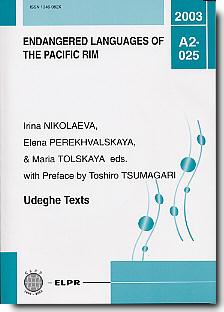
目次
CONTENTS
CONTENTS
| Preface | 1 |
| Abbreviations | 5 |
| Introduction | 7 |
| Plates | 13 |
| Tales | 17 |
| Stories and Legends | 105 |
| Songs | 193 |
| References | 209 |
トーニャ・ステビンス (序文 笹間 史子)
『危機言語とのたたかい —コミュニティにむけた海岸ツィムシアン語研究』(A2-026)
Tonya STEBBINS with Introduction by Fumiko SASAMA
"Fighting Language Endangerment:
Community Directed Research on Sm'algyax (Coast Tsimshian)"
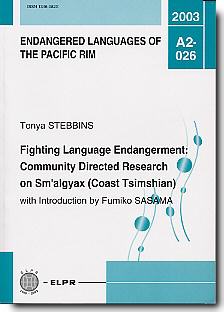
目次
CONTENTS
CONTENTS
| Introduction | |
| Preface | vii |
| Acknowledgements | xi |
| Note on examples | xiii |
| List of abbreviations | xiv |
| Maps | xvi |
| Part One: Community directed language documentation | 1 |
| Chapter One: Responding effectively to language endangerment | 3 |
| Part Two: Sm'algyax: the language of the Tsimshian Nation | 13 |
| Chapter Two: History of Sm'algyax and the Tsimshian Nation | 15 |
| Chapter Three: Sm'algyax Today | 52 |
| Chapter Four: Introduction to Sm'algyax Grammar | 73 |
| Part Three: Community directed language documentation in practice | 119 |
| Chapter Five: Dictionary Design for the Sm'algyax Learners' Dictionary | 121 |
| Chapter Six: Lexical expansion in Sm'algyax | 153 |
| Chapter Seven: Representing Sm'algyax words through English | 173 |
| Chapter Eight: Polysemy and homonymy in the Sm'algyax Learners' Dictionary | 190 |
| Chapter Nine: Spelling in Sm'algyax | 215 |
| Chapter Ten: Variation in Sm'algyax | 244 |
| Part Four: Reflections on the community directed approach | 263 |
| Chapter Eleven: Community directed language work: requirements and outcomes | 264 |
| References | 277 |
中山 俊秀 編 『キャロライン・リトル語りによる
ヌートカ語アハウザット方言テキスト資料』 (CD2枚付き)(A2-027)
Toshihide NAKAYAMA ed. "Caroline Little's Nuu-chah-nulth (Ahousaht)
Texts with Grammatical Analysis" (with 2 CDs)
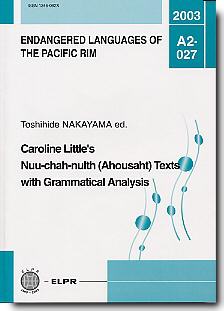
目次
CONTENTS
CONTENTS
| Introduction | vii |
| List of Abbreviations | xii |
| Part1: Nuu-chah-nulth-English Parallel Texts 1〜15 | 3 |
| Part2: Interlinear Texts 1〜15 | 99 |
中山 俊秀 編 『ジョージ・ルイ語りによる
ヌートカ語アハウザット方言テキスト資料』 (CD2枚付き)(A2-028)
Toshihide NAKAYAMA ed. "George Louie's Nuu-chah-nulth (Ahousaht)
Texts with Grammatical Analysis" (with 2 CDs)

目次
CONTENTS
CONTENTS
| Introduction | vii |
| List of Abbreviations | xi |
| Part1: Nuu-chah-nulth-English Parallel Texts 1〜9 | 3 |
| Part2: Interlinear Texts 1〜9 | 155 |
小野 智香子(序文 呉人 恵)
『イテリメン語北部方言 語彙・会話例文集』(A2-029)
Chikako ONO with Preface by Megumi KUREBITO
"ТЕМАТИЧЕСКИЙ СЛΟВΑΡЬ И
ΡАЗГОВОРНИК СΕΒΕРНОГО (СЕДАНКИНСКОГО)
ДИАЛЕКТА ИТЕЛЬМЕНСКОΓО ЯЗЫКА /
A Lexicon of Words and Conversation Phrases for the Itelmen Northern Dialect"
目次
CONTENTS
CONTENTS
| Preface | 1 |
| Vocaburary and Conversation Phrases in the Northern Dialect of the Itelmen / イテリメン語北部方言語彙・会話例文集 | 13 |
| Pronouns / 代名詞 | 14 |
| Numerals / 数 | 16 |
| Size / 大きさ | 16 |
| Form / 形 | 18 |
| Features of objects / 物の特徴 | 18 |
| Features of people / 人の特徴 | 20 |
| Actions / 動作・行為 | 22 |
| Water, land and landscape / 水場・陸地・地形 | 96 |
| Plants and parts of plants / 植物・植物の部分 | 98 |
| Animals / 動物 | 100 |
| Birds / 鳥 | 100 |
| Fish / 魚 | 102 |
| Insects and worms / 虫 | 102 |
| Body parts of animals / 動物の体の部分 | 104 |
| Body parts of humans / 人間の体の部分 | 104 |
| Life / 生活 | 108 |
| Clothes / 衣服 | 110 |
| People / 人 | 110 |
| Professions / 職業 | 112 |
| In a house / 家 | 112 |
| Affirmatives and negatives / 肯定・否定 | 114 |
| Weather / 天気 | 116 |
| Conversation / 会話 | 118 |
| On the street / 道・外での出会い | 120 |
| Arrival at villages or cities / 村(町)への到着 | 122 |
| Work / 仕事 | 124 |
| Time / 時・時間 | 126 |
| Transportation / 移動・運搬 | 128 |
| At home / 家で | 132 |
| Family / 家族 | 136 |
| At a village / 村 | 142 |
| Transportation / 移動・輸送 | 142 |
| At the airport / 空港で | 144 |
| At a hotel / ホテルで | 144 |
| At a kindergarten / 幼稚園 | 148 |
| At a shop / 店・商店 | 152 |
| At the post office / 郵便局 | 154 |
| At the hospital / 病院 | 156 |
| At a police station / 警察署で | 160 |
| Sports / スポーツ | 164 |
| At a club / クラブ | 164 |
| At school / 学校で | 168 |
風間 伸次郎 採録・訳注『エウェン語 テキストと文法概説(ツングース言語文化論集23)』 (CD1枚付き)(A2-030)
Shinjiro KAZAMA ed. "Ewen Texts and Grammar (Publications on Tungus Languages and Cultures 23)" (with 1 CD) (in Japanese)
目次
| Summary | 1 |
| まえがき | 2 |
| あらすじ (露文) | 5 |
|
テキスト本文 (キリル文字に基づく音韻表記) Texts in Cyrillic transcription |
27 |
| あらすじ (和文) | 56 |
|
テキスト本文 (ラテン文字に基づく音韻表記とその日本語訳) Texts in Roman transcription with Japanese translation |
|
|
1. どんなにかそのおじいさんは好きだったか、聞くことを、話を How the old man was fond of listening to the folk tales. |
64 |
|
2. どうやってそのおじいさんは裕福になったか How the man got rich. |
75 |
|
3. どうやってある人が助けたか、貧しい者たちを How the man helped the poor people. |
104 |
|
4. おじいさんとおばあさんとその息子がいる There lived an old couple and their son. |
119 |
|
5. いじめてはならない、貧しい者を、孤児を Don't teae poor people and orphans. |
139 |
| エウェン語の音韻 | 150 |
| エウェン語接尾辞・小辞一覧表 | 154 |
| エウェン語文法概説 | 158 |
大島 稔『ベーリング島アリュート言語資料 辞典とテキスト』(A2-031)
Minoru OSHIMA "Linguistic Materials of Bering Island Aleut:
Dictionary and Texts/
Материалы об алеутском языком на
острове Беринга: словарь и тексты"
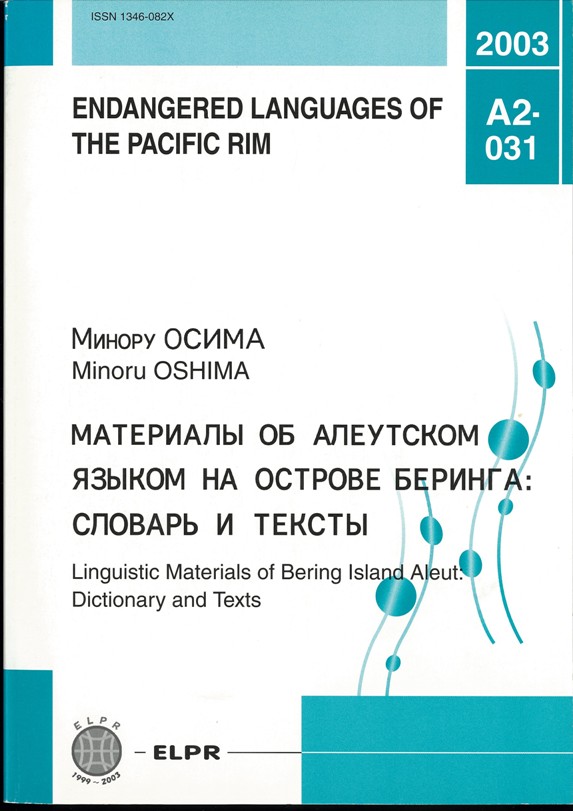
CONTENTS
| Acknowledgements | v |
| Format and notation of dictionary | vii |
| Dictionary | 1 |
| Texts: Dialogues and stories | 309 |
| Index for Russian - Aleut | 321 |
| Index for English - Aleut | 335 |
奥田 統己・林 誠・田村 すず子 編『アイヌ語静内方言の音声資料―田村すず子採録
織田ステノさんと虎尾ハルさんの口頭文芸と会話』(CD1枚付き)(A2-032)
Osami OKUDA, Makoto HAYASHI and Suzuko TAMURA eds.
"Ainu Language: Audio Recordings of the Shizunai Dialect ―
Oral Literature and Conversation of Suteno ORITA and Haru TORAO
Recorded by Suzuko TAMURA" (with 1 CD)

目次
| はじめに | v |
| 語り手の紹介と録音の経緯 | v |
| 資料の概要 | vi |
| 凡例 | ix |
| 本文1 | 1 |
| 本文2 | 19 |
| 本文3 | 69 |
| 本文4 | 101 |
| アイヌ語索引 | 137 |
| A brief Introduction in English | 154 |
津曲 敏郎 編『環北太平洋の言語 第10号』(A2-033)
Toshiro TSUMAGARI ed. "Languages of the North Pacific Rim Volume 10"
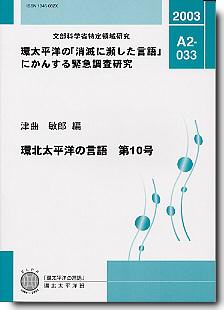
目次
CONTENTS
CONTENTS
|
活格タイプとしてのハイダ語
Haida, an Active Type Language |
堀博文 Hirofumi HORI |
1 |
|
シベリア・ユピック語の人称の屈折を示す代名詞的指示詞について
On Pronominal Demonstratives in Central Siberian Yupik |
永井佳代 Kayo NAGAI |
19 |
|
コリマ・ユカギール語のS=Aタイプの自他対応について
S=A Type of Intransitive and Transitive Verbs in Kolyma Yukaghir |
長崎郁 Iku NAGASAKI |
33 |
|
ウイルタ語の非人称完了動名詞否定形について
On the Negative Impersonal Perfect Verbal-noun in Uilta |
池上二良 Jirô IKEGAMI |
45 |
|
シベ語の助数詞について
Classifiers in Sibe |
木村滋雄 Shigeo KIMURA |
49 |
|
シネヘン・ブリヤート語音韻体系概説
An Outline of the Shinekhen Buryat Phonology |
山越康裕 Yasuhiro YAMAKOSHI |
69 |
|
イテリメン語北部方言基礎語彙調査報告(追補)
Additional Basic Vocabulary of Itelmen Northern Dialect |
小野智香子 Chikako ONO |
87 |
|
アイヌ語沙流方言の昔話 上田トシのウエペケレ2
Folktales of the Saru Dialect of Ainu — Ueda Toshi's Uepeker 2 — |
白石英才 Hidetoshi SHIRAISHI |
111 |
|
内モンゴル北部におけるモンゴル系諸言語比較基本語彙
A Comparative Basic Vocabulary for Some Mongolic Languages Spoken in Northern Inner Mongolia |
山越康裕 Yasuhiro YAMAKOSHI |
139 |
|
アイヌ語三石方言の基礎語彙
Basic Vocabulary for the Mitsuishi Dialect of Ainu |
加藤陽一郎 Yoichiro KATO |
215 |
田村 すず子 編『アイヌ語沙流方言の音声資料3 —
近藤鏡二郎の録音テープに遺されたワテケさんの神謡III』(CD1枚付き)(A2-034)
Suzuko TAMURA ed. "Ainu Language: Audio Recordings of the Saru Dialect 3 —
Mythical Chants Recited by Wateke, Preserved on Tape Recorded by Kyojiro Kando III" (with 1 CD)
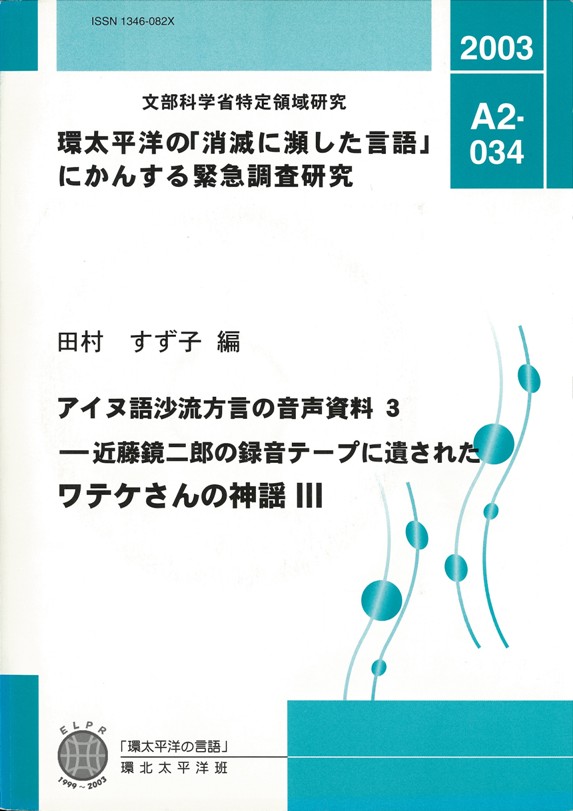
目次
|
はしがき
Preface |
iii |
|
研究経過
REcord of Research Progress |
1 |
|
語り手紹介
Speaker Introduction |
6 |
|
録音者紹介
Recorder Introduction |
8 |
|
凡例
Transcription, Abbrebiation, etc. |
10 |
|
話者の方言所在地
Speaker Consultants' Dialect Site |
45 |
|
ワテケさんの神謡
Mythical Chants Recited by Wateke |
47 |
|
8. a=wakkatare hekaci wakkata kopan
水汲みを言いつけられた少年が水汲みをいやがった Boy Told to Draw Water Unwilling to Draw Water |
49 |
|
補説
Supplement |
82 |
|
9. Erum or ta
襟裳岬で at Erimo Point |
93 |
|
補説
Supplement |
126 |
|
10. Okikurmi kamuy turesihi kotan esikarun Sísirmuka esikarun
オキクルミ神の妹が人間の村シシリムカを恋う God Okikurumi's Sister Missed the Human Village, Sisirmuka |
133 |
|
補説
Supplement |
156 |
|
索引
Indexes |
163 |
|
行索引
Line Index |
165 |
|
単語索引
Word Index |
169 |
|
神謡6〜10の旋律・抑揚譜
Melody and Intonation Diagrams for Mythical Chants 6 through 10 |
173 |
永山 ゆかり 編 (序文 呉人 恵)
『コリヤークの民話 「ふしぎななわ」』(A2-035)
Yukari NAGAYAMA ed. with Preface by Megumi KUREBITO,
"ВОЛШЕБНАЯ ВЕРЕВКА (КОРЯКСКАЯ СКАЗКА)/
The Magic Rope (Koryak Folktale)"
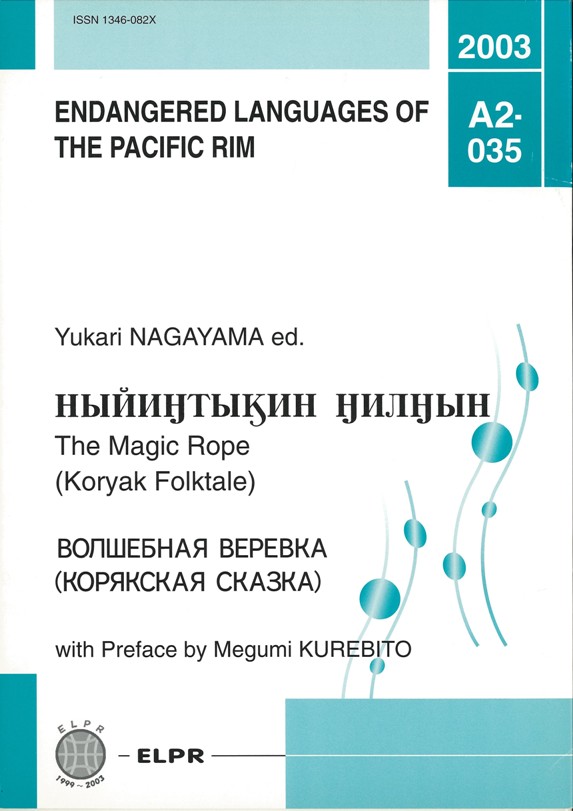
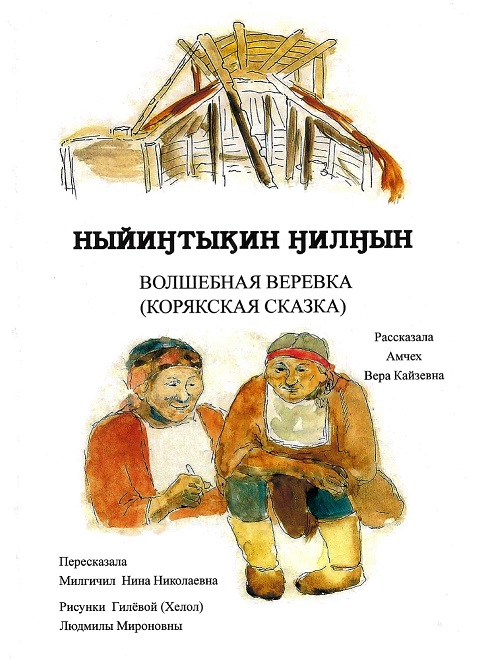
白石 英才, ガリーナ・D. ローク 編(序文 中川 裕)
『ニヴフ語音声資料2―アムール方言の民話と歌謡―』(CD1枚付き)(A2-036)
Hidetoshi SHIRAISHI and Galina D. Lok eds. with Preface by Hiroshi NAKAGAWA
"Sound Materials of the Nivkh Language 2
— Folktales and Songs of the Amur Dialect — "
(with 1 CD)
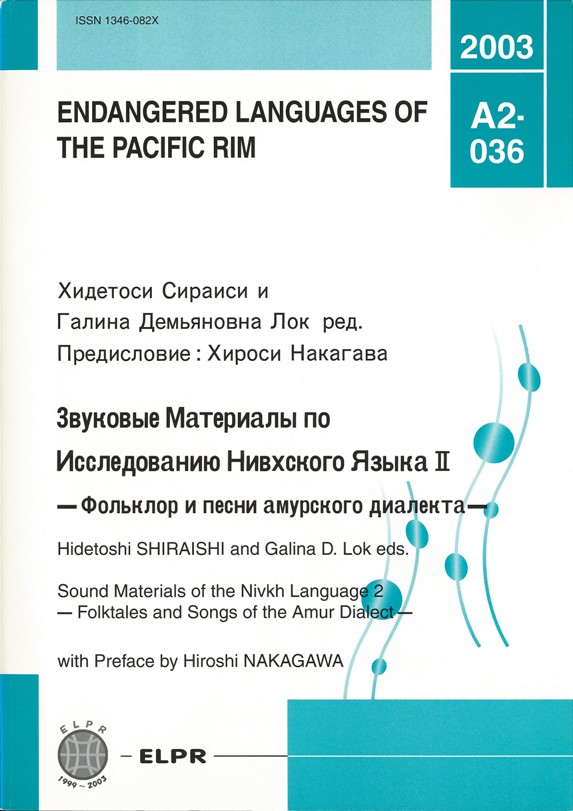
目次
CONTENTS
CONTENTS
|
Pictures 写真 |
iii |
|
Maps 地図 |
vii |
|
Preface 序文 |
ix |
|
Introduction はじめに |
xv |
|
Folktales and Songs of the Amur Dialect アムール方言の民話と歌謡 |
1 |
|
1. k'ysk 'Cats' 「猫」 |
2 |
|
2. k'ola ytik 'Grandmother Rich' 「金持ち婆さん」 |
11 |
|
3. atik ge kins 'The Evil Spirit that Kidnapped the Sister' 「妹を誘拐した悪魔」 |
40 |
|
4. olgon ogla 'The Pig-Babies' 「豚の赤ん坊」 |
45 |
|
5. Songs of the Amur Dialect 「アムール方言の歌謡」 |
65 |
|
English translation 英訳 |
82 |
|
Abstract in Japanese 日本語抄訳 |
101 |
|
Contents (in Russian) 目次(ロシア語) |
114 |
風間 伸次郎『ツングース諸語における基礎語彙(A)』(CD1枚付き)(A2-037)
Shinjiro KAZAMA "Basic Vocabulary (A) of Tungusic Languages" (with 1 CD)
CONTENTS
| Introduction | 1 |
| Resource: Fieldwork and Consultants | 3 |
| Genetical Relationship and Phonetic Changes (esp. concerning to consonants) | 6 |
| An outline of Phonological systems of every language | 12 |
| Presentation of the Data | 16 |
| Reference Section | 135 |
| References | 139 |
永山 ゆかり(序文 津曲 敏郎)『アリュートル語文法概説』(A2-038)
Yukari NAGAYAMA with Preface by Toshiro TSUMAGARI
"Очерк грамматики алюторского языка
/ Grammatical Outline of Alutor"
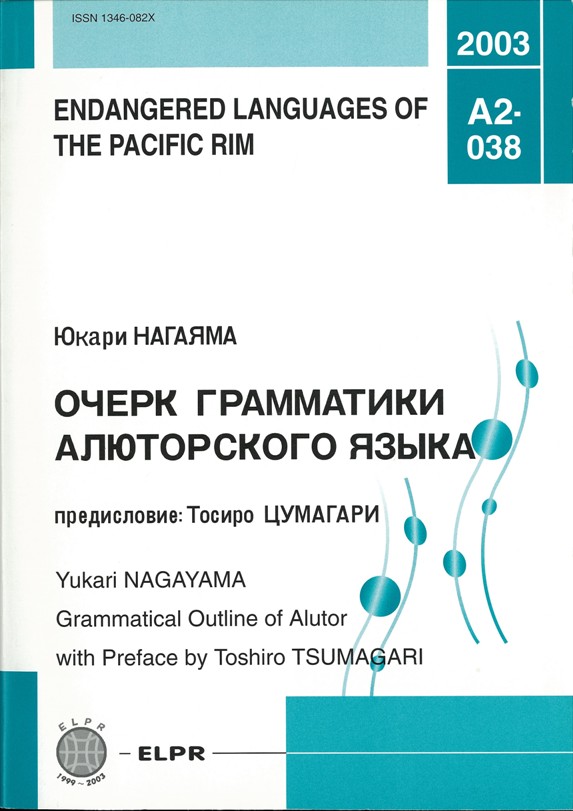
CONTENTS
| Preface | iii |
北原 次郎太・田村 雅史・田村 将人・丹菊 逸治・田村 すず子 共編
『アイヌ語樺太・名寄・釧路方言の資料 — 田村 すず子採録 藤山 ハルさん・山田 ハヨさん・
北風 磯吉さん・徹辺 重次郎さんの口頭文芸・語彙・民族誌』(CD1枚付き)(A2-039)
Jirota KITAHARA, Masashi TAMURA, Masato TAMURA, Ituji TANGIKU and Suzuko TAMURA eds.
"Ainu Language: Audio Recordings and Transcribed Materials of the Sakhalin,
Nayoro and Kushiro Dialects — Oral Literature, Vocabulary and Ethnographic Data
from Haru FUJIYAMA, Hayo YAMADA, Isokichi KITAKAZE and Jujiro TESHIBE" (with 1 CD)
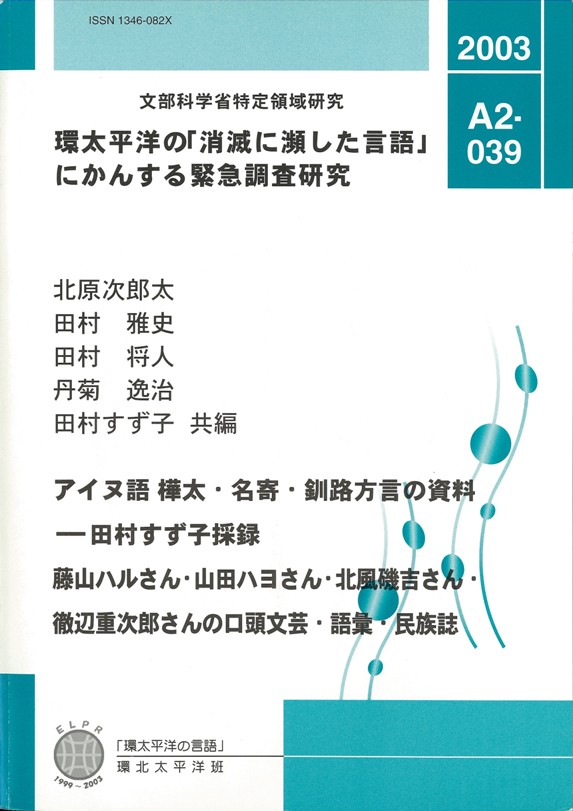
目次
|
第 I 編 アイヌ語樺太方言のアイヌ語音声資料
— 藤山ハルさんの口頭文芸と歌 — |
2 |
|
第 II 編 アイヌ語樺太方言の資料
— 山田ハヨさんの語彙と口頭文芸 — |
171 |
|
第 III 編 アイヌ語名寄方言の音声資料
— 北風磯吉さんの口頭文芸と語彙 — |
203 |
|
第 IV 編 アイヌ語釧路方言の資料
— 徹辺重次郎さんの語彙と口頭文芸 — |
240 |
| Summary | 330 |
渡辺 己『スライアモン語(本土コモックス・セイリッシュ語)形態法記述 統語法概説』
(A2-040)
Honoré WATANABE "A Morphological Description of Sliammon,
Mainland Comox Salish, with a Sketch of Syntax"
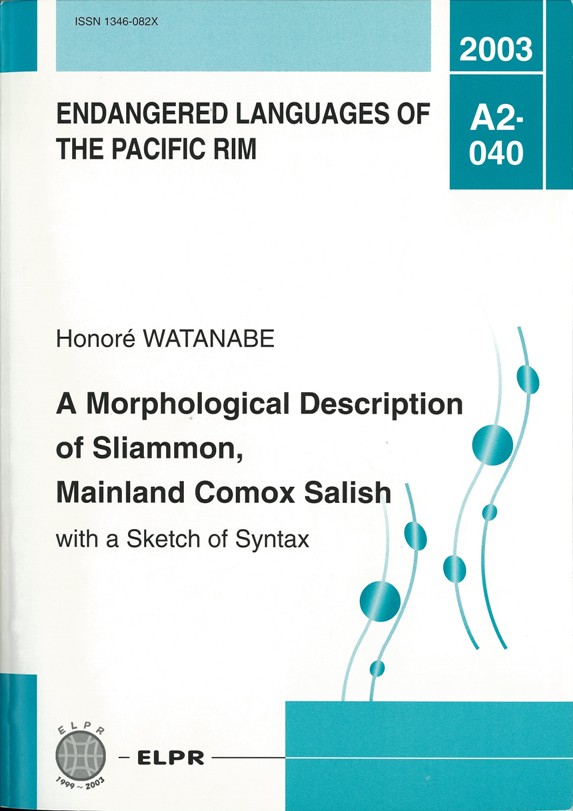
CONTENTS
| Acknowledgements | xii |
| Symbols and Abbreviations | xv |
| Introduction | 1 |
| PART 1. PHONOLOGY | 8 |
| 1. Introduction to Part 1: Phonology | 8 |
| 2. Morphophonemic processes | 13 |
| 3. Phonotactic | 19 |
| 4. Suprasegmentals | 20 |
| 5. Special questions | 30 |
| PART 2. A SKETCH OF SYNTAX | 37 |
| 6. Introduction to Part 2: A Sketch of Syntax | 37 |
| 7. Affixes and clitics | 38 |
| 8. Pronominal Subject markers | 52 |
| 9. Independent pronouns | 63 |
| 10. Word classes | 65 |
| 11. Noun phrases | 79 |
| 12. Simple and complex predicates | 87 |
| 13. Clause types | 99 |
| 14. Relative clauses | 122 |
| 15. Fronting constructions | 146 |
| PART 3. MORPHOLOGY | 167 |
| 16. Introduction to Part 3: Morphology | 167 |
| 17. Roots | 170 |
| 18. Voice | 179 |
| 19. Lexical suffixes | 307 |
| 20. Reduplication | 371 |
| 21. Aspect | 407 |
| 22. Ablaut plural | 459 |
| 23. Abstract affixes | 471 |
| 24. Numerals | 500 |
| 25. Clitics | 509 |
| 26. Special questions | 532 |
| PART 4. ILLUSTRATIVE TEXTS | 537 |
| 27. Introduction to Part 4: Illustrative texts | 537 |
| 28. Text 1: The Basket Ogre | 538 |
| 29. Text 2: Mink and Grizzly | 548 |
| References | 593 |
ルシル・ワタホミジー, ジョージン・ベンダー, マリンダ・ポースキー,
ジョーシー・スティール, フィルバート・ワタホミジーSr., アキラ・ヤマモト 共編
『ワラパイの言葉:ワラパイ-英語辞書』(A2-041)
Compiled by Lucille J.Watahomigie, Jorigine Bender, Malinda Powskey,
Josie Steele, Philbert Watahomigie Sr., and Akira Y. YAMAMOTO
"A Dictionary of the Hualapai Language"
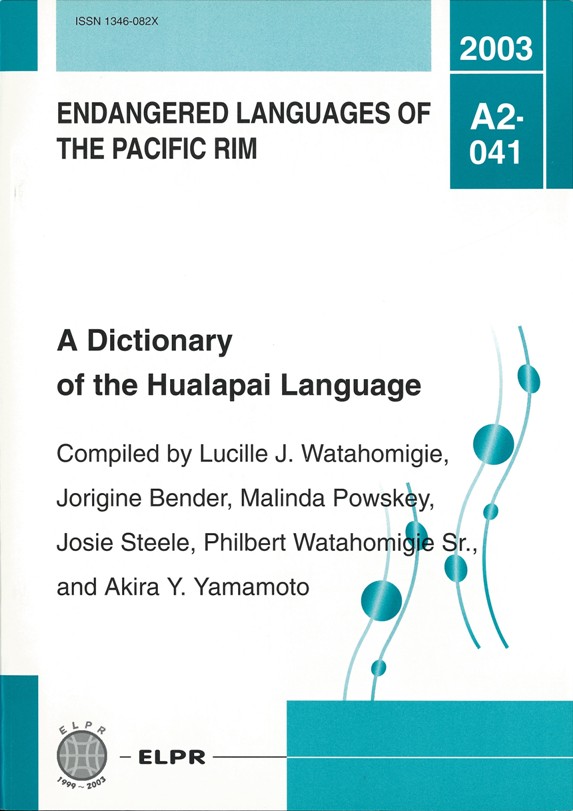
CONTENTS
| Introduction | vi |
| Part I Hwalbáy (Hualapai) to English | 1 |
アレクサンドル・E・キブリック, サンドロ・V・カザーソフ,
イリーナ・A・ムラヴョーヴァ, 呉人 恵 編 アレクサンドル・E・キブリック,
イリーナ・A・ムラヴョーヴァ, 呉人 恵, 永山 ゆかり 共訳
『アリュートルの言語とフォークロア』(A2-042)
Aleksantr E. KIBRIK, Sandro V. KODZASOV and Irina A. MURAVYOVA,
Edited by Megumi KUREBITO. Translated by Aleksandr E. KIBRIK,
Irina A. MURAVYOVA, Megumi KUREBITO, Yukari NAGAYAMA
"Language and Folklore of the Alutor People"
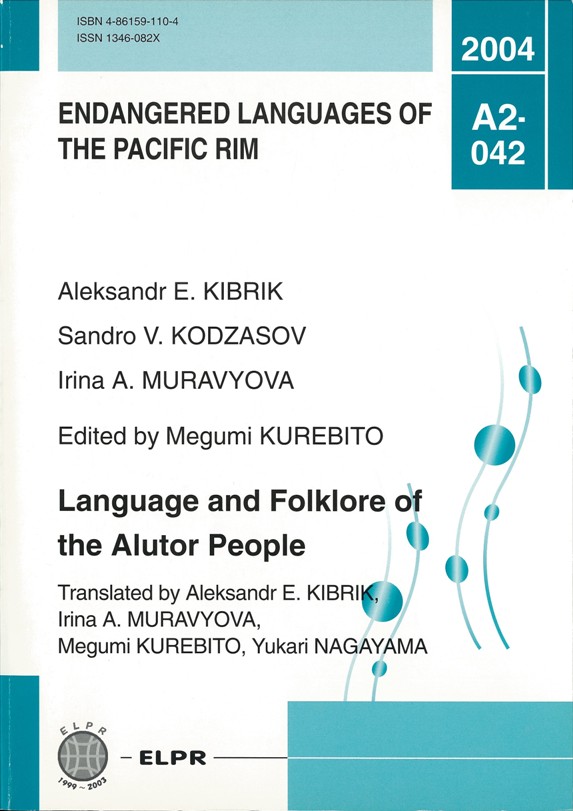
CONTENTS
| FOREWORD FOR THE ENGLISH VERSION | xi |
| EDITOR'S WORD | xiii |
| ABBREVIATIONS AND SYMBOLS | xxiii |
| PREFACE | 1 |
| PART I. ALUTOR FOLKLORE | 9 |
| INTRODUCTIONS | 9 |
| 1.FOLKTALES | 12 |
| 2. NARRATIVES ABOUT THE PAST | 74 |
| 3. CUSTOMS AND HABITS | 158 |
| 4. HISTORIES FROM LIEVES | 164 |
| PART II. ALUTOR GRAMMAR | 203 |
| CHAPTER 1. Phonology | 203 |
| CHAPTER 2. Morphology | 237 |
| CHAPTER 3. Syntax | 307 |
| PART III. ALUTOR-ENGLISH DICTIONARY | 339 |
| Introduction | 339 |
| ROOT DICTIONARY | 343 |
| AFFIX DICTIONARY | 617 |
| APPENDIX. Samples of Verb Conjugation | 639 |
| REFERENCES | 649 |
宮岡 伯人, 遠藤 史 編 『環北太平洋の言語 第9号』(A2-043)
Osahito MIYAOKA and Fubito ENDO eds. "Languages of the North Pacific Rim : Volume 9"

CONTENTS
| I. Proceedings of the Session of the North Pacific Rim Research Section (A2), ELPR, at Kyoto Conference 2002 | ||
| Verbal Agreement in Jemez Towa | Yukihiro YUMITANI | 3 |
| Grammatical Analysis Situated in Structural Environment: The Case of the Perspective-Shifting Construction in Nootka | Toshihide NAKAYAMA | 17 |
| 'Posessive' and 'Relational' in Koryak Viewed from the Animacy Hierarchy | Megumi KUREBITO | 35 |
| Contrasting "Altaic" Languages (Turkic, Mongolian and Tungusic Languages) with Special Reference to Noun Categories (Case) | Shinjiro KAZAMA | 47 |
| Portable Optical Player for Old Phonograph Wax Cylinders | Takashi NAKAMURA | 63 |
| Minority Languages in Modern Russia | Albina H. GIRVANOVA | 69 |
| NGO as a Link between Linguist and Community | Toshiro TSUMAGARI | 79 |
| II | ||
| Classification of Reciprocals and Sociatives in Ainu | Anna BUGAEVA | 85 |
| A Report on Koryak Phonology | Megumi KUREBITO | 117 |
| Come and Go in Modern Uyghur | Izumi NISHIOKA | 145 |
| Itelmen Verb Stem: Morphological Features and Syntactic Structure of Intransitive and Transitive | Chikako ONO | 169 |
| Phonologically Driven Allomorphy of Nivkh Transitive Verbs — With Implications for the Nature of Prefix i- | Hidetoshi SHIRAISHI | 179 |
| Endangered Language Fieldwork, Documentation and Publication: Lessons from the Experience of a Field Linguist | Suzuko TAMURA | 197 |
長崎 郁・遠藤 史 編
『コリマ・ユカギール語例文付き語彙集』(A2-044)
Iku NAGASAKI and Fubito ENDO eds. "Kolyma Yukaghir Vocabulary
with Illustrative Sentences"
目次
| 凡例 | xiii |
| ロシア語文字転写一覧 | xv |
| コリマ・ユカギール語例文付き語彙集 | 1 |
| 接尾辞一覧 | 97 |
| 参考文献 | 108 |
ブエガワ・アンナ(序文 佐藤 知己)『アイヌ語千歳方言の文法と口承文芸
— 小田イトの個人語 —』(CD1枚付き)(A2-045)
Anna BUGAEVA, Preface by Tomomi SATO
"Grammar and Folklore Texts of the Chitose Dialect of Ainu
(Idiolect of Ito Oda)" (with 1 CD)
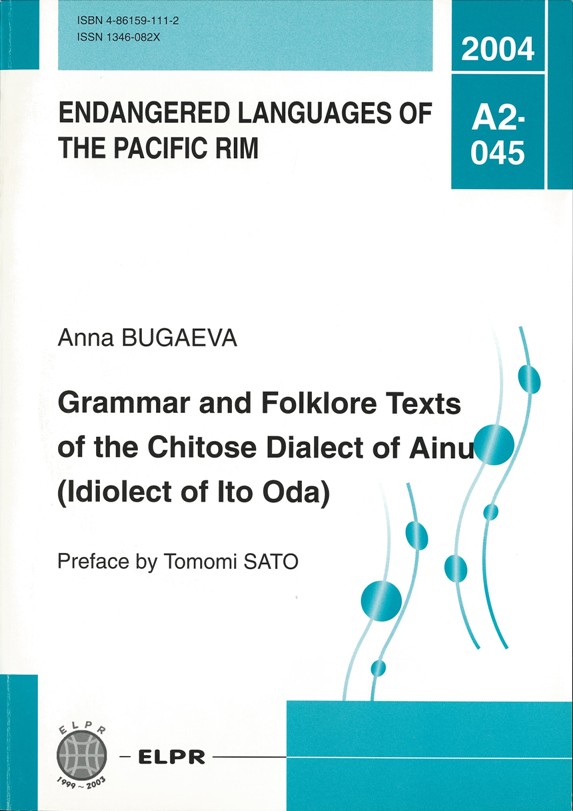
CONTENTS
| Grammar of the Chitose Dialect of Ainu (Idiolect of Ito Oda) | 1 |
| Annotated Folklore Texts of the Chitose Dialect ofAinu Recited by Ito Oda | 109 |
| Appendix. Index | 423 |
シャルル・ウェンステン 編注・仏訳(序文 呉人 徳司)
『ボゴラズ採集による チュクチの神話・民話テキスト』(CD2枚付き) (A2-046)
Retranscribed, checked and translated into French by Charles Weinstein
"The Chukchi Myths and Folklore Texts Collected by Vladimir Bogoraz"
(with 2 CDs) Preface by Tokusu KUREBITO

CONTENTS
| Preface | iii |
| Introduction (Russian) | vii |
| Introduction (French) | xx |
| Official Chukchi orthography | xxxiii |
| Some Chukchi terms and toponyms | xxxiv |
| Chukchi texts (1900) | 1 |
| French translation (1900) | 59 |
| Chukchi texts (1910-13) | |
| Myths and tales | 159 |
| Invocations | 220 |
| Songs, Proverbs, riddles and sayings | 227 |
| French translation (1910-13) | 231 |

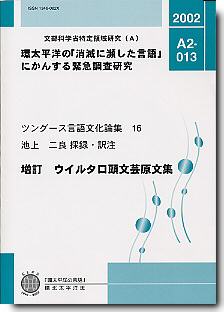 全文PDF/Fulltext PDF
全文PDF/Fulltext PDF
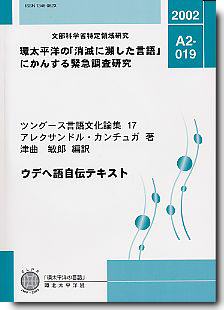 全文PDF/Fulltext PDF
全文PDF/Fulltext PDF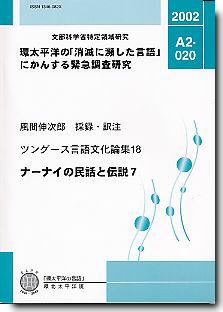 全文PDF/Fulltext PDF
全文PDF/Fulltext PDF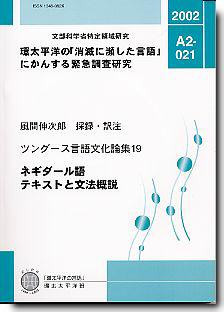 全文PDF/Fulltext PDF
全文PDF/Fulltext PDF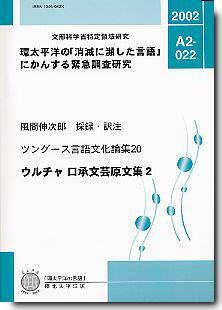 全文PDF/Fulltext PDF
全文PDF/Fulltext PDF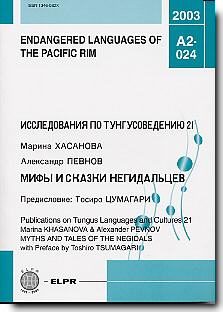
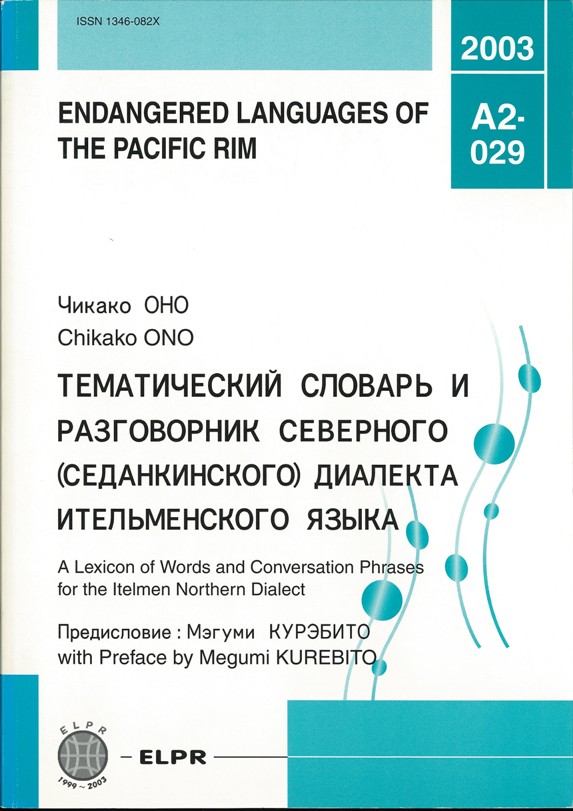 全文PDF/Fulltext PDF
全文PDF/Fulltext PDF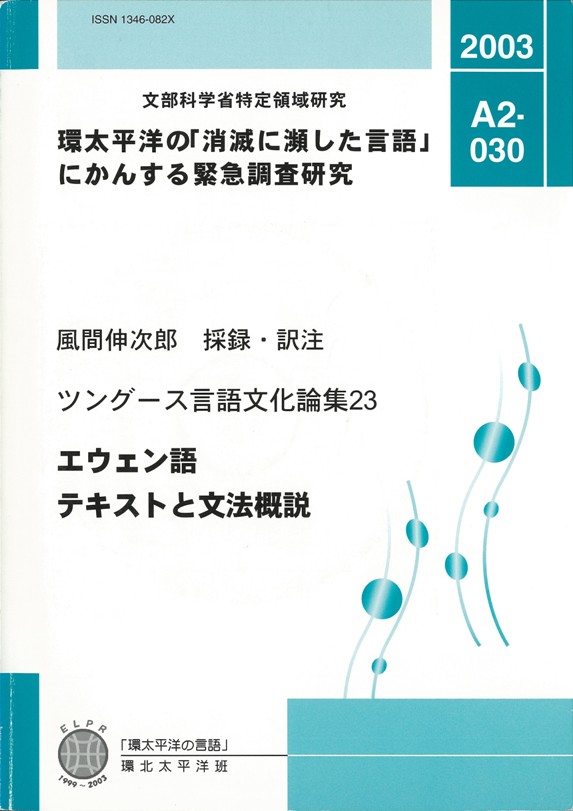 全文PDF/Fulltext PDF
全文PDF/Fulltext PDF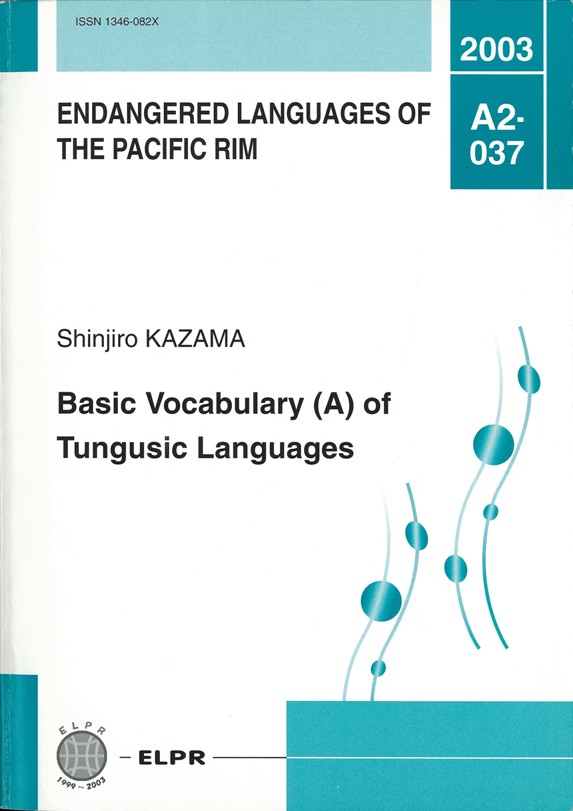 全文PDF/Fulltext PDF
全文PDF/Fulltext PDF